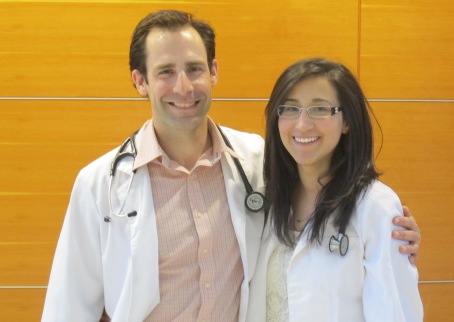
Roy Ulrich and Emma Heyardi will stay at the University of Alberta as a CaRMS couple match.
When Emma Heydari and Roy Ulrich graduate from U of A medical school in June, Alberta will gain two future physicians. But medical school brought Heydari and Ulrich much more than the opportunity to pursue their medical careers in their home province. It also brought them together.
The couple met during their first year in a small group session. "I was sitting next to Emma and noticed what ridiculously neat writing she had," says Ulrich. "It didn't even look like English to me so I asked her what language it was." Heydari may have thought he was crazy at the time but they started dating about six months later and have been together ever since. Ulrich proposed April 18, immediately after they both finished their fourth-year comprehensive exams, in a scenario involving roses and a giant stuffed Winnie the Pooh with an engagement ring sewn to his paw. They plan to get married in August 2015.
"Medical school has really shown us the best and the worst of each other," says Heydari of their four-year courtship during busy and stressful years in medical school. "I am the more stressed out, hyper one and he is much more calm in general. I told him if we can get through CaRMS together we should get married."
CaRMS (Canadian Resident Matching Service) is Canada's electronic application and match for graduating medical students to gain entry into residency positions throughout the country. Heydari and Ulrich entered the match as a couple in hopes of getting residency positions in the same location, or at least near one another. It was an added level of pressure to what is already a very anxious time for students.
"You have to submit your rankings of schools as a couple and consider all the permutations and combinations of different programs," says Ulrich. "We submitted a list of 180, after much arguing and compromising."
To further complicate the match, Ulrich, a former bomb engineer who did a tour of duty in Afghanistan, was in the process of leaving the military around the same time. After wrestling with the decision for months, he left the military to pursue psychiatry, his passion, rather than the field of medicine dictated by the military. It also gave him a better chance to be with Heydari and live and work in a place of their own choosing. But it meant repaying the hefty bill the military had footed to put him through medical school - about $250,000. Since the military did not formally release him until December and the application deadline for the CaRMS match process was November, it created even more difficulties. Ulrich credits the Faculty of Medicine & Dentistry for helping him through it all.
"The Faculty really went to bat for me and worked hard to help me," says Ulrich, citing Kent Stobart, associate dean of undergraduate medical education, for his tireless work in convincing other schools to allow Ulrich's late applications because of his unique situation.
On match day, both Heydari and Ulrich got their first choices - pediatrics and psychiatry, both at the U of A. Since the two and their families are from Edmonton, they are especially delighted with this result and plan to stay here long-term to practise medicine.
"There are so many advantages here compared to other places where we did electives," says Heydari, mentioning the U of A's world-class facilities and research and Alberta Netcare, the province's unique internet-based health record system, as tremendous advantages for treating patients.
It's also a great place for a wedding.